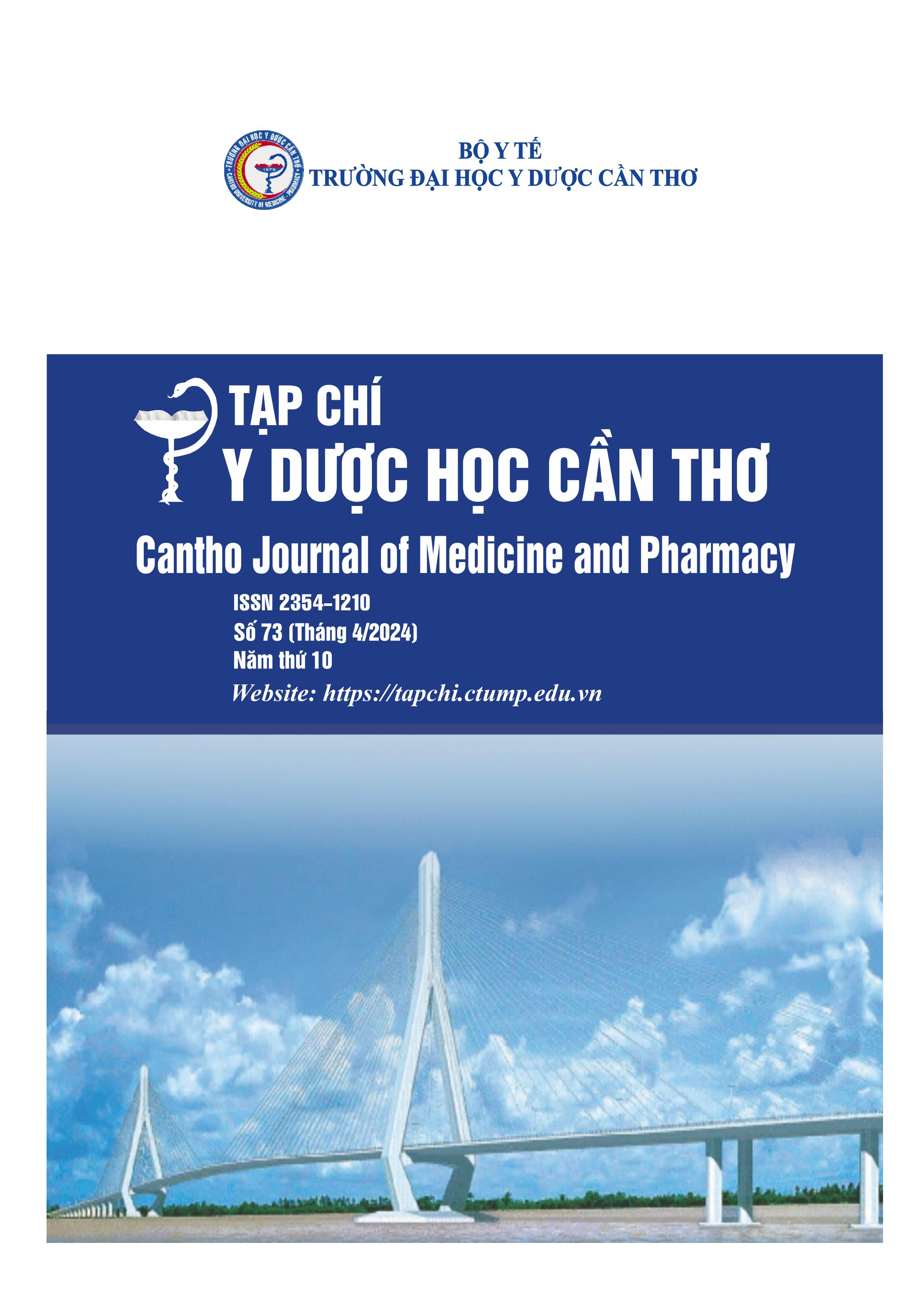RESEARCH ON CLINICAL CHARACTERISTICS AND RISK FACTORS OF PARENTS WITH RECURRENT CEREBRAL INFARCTION IN CAN THO CENTRAL GENERAL HOSPITAL
Main Article Content
Abstract
Background: Recurrent cerebral infarction accounts for a high rate in recent years and increases the rate of disability, death and burden to society many times more than the first cerebral infarction. The investigation of clinical characteristics and some risk factors provides important information in the assessment and prevention of recurrent ischemic stroke. Objectives: To describe the clinical characteristics and characteristics of some risk factors of patients with recurrent cerebral infarction. Materials and methods: A case series descriptive study, prospective on 61 patients diagnosed with recurrent cerebral infarction at the Department of Internal Neurology, Can Tho Central General Hospital from June 2022 to June 2023. Results: There were 27 female patients and 34 male patients with mean age of 66.05 ± 1.51 years old, patients relapsed mainly after 12 months (67.2%) since the previous time, the situation of onset when the patient was at rest prevailed (47.5%) with a gradual and progressive nature (55.7%). Symptoms of hemiplegia, difficulty speaking, numbness of hands and feet account for >50% of cases. NIHSS at admission was 6.87 ± 0.57. High blood pressure, smoking, and diabetes are major risk factors. Conclusions: In our study, cerebral infarction recurred mainly after 12 months from the previous time, hemiplegia, speech difficulty and loss of sensation prevailed. High blood pressure, smoking, and diabetes are common risk factors.
Article Details
Keywords
Cerebral infarction, recurrence, clinical, risk factors
References
2. Đinh Hữu Hùng. Nguy cơ tái phát sau đột quỵ thiếu máu não cục bộ cấp theo phân tầng một số yếu tố liên quan. Đại học Y Dược thành phố Hồ Chí Minh. 2014.
3. Nguyễn Văn Dũng và cộng sự. Các yếu tố liên quan đến tái phát muộn sau đột quỵ thiếu máu não cấp tại Tiền Giang. Tạp chí y học Việt Nam. 2017. 503 (1), 82-87.
4. Quách Hoàng Kiên, Phạm Thị Ngọc Quyên, Nguyễn Bá Thắng, . Đánh giá nguyên nhân và một số yếu tố liên quan ở bệnh nhân đột quỵ thiếu máu não cục bộ tái phát. Y học TP.Hồ Chí Minh. 2021. 25 (2), 47 - 53.
5. Khanevski, A. N., Bjerkreim, A. T., Novotny, V., Naess, H., Thomassen, L., et al. Recurrent ischemic stroke: Incidence, predictors, and impact on mortality. Acta Neurol Scand. 2019. 140 (1), 3-8, https://doi.org/10.1111/ane.13093.
6. Che, B., Shen, S., Zhu, Z., Wang, A., Xu, T., et al. Education Level and Long-term Mortality, Recurrent Stroke, and Cardiovascular Events in Patients With Ischemic Stroke. J Am Heart Assoc. 2020. 9 (16), e016671. https://doi.org/10.1161/jaha.120.016671
7. Lê Xuân Dương, Phạm Quang Trình, Nguyễn Đức Ninh, Nguyễn Tiến Dũng, Nguyễn Thị Hoa và cộng sự. Đặc điểm lâm sàng, cận lâm sàng 6.007 bệnh nhân đột quỵ não cấp tính, điều trị tại Khoa Cấp cứu, Bệnh viện Trung ương Quân đội 108, năm 2018-2019. Tạp Chí Y học Quân sự. 2022. 360 29-33.
8. Lê Uy Nghiêm, Lê Văn Minh, Mai Long Thủy. Nghiên cứu đặc điểm lâm sàng, hình ảnh CTScaner sọ não và đánh giá kết quả điều trị nội khoa trên bệnh nhân nhồi máu não tại Bệnh viện
Đa khoa Trung ương Cần Thơ năm 2015 - 2017. Y dược học Cần Thơ. 2018. 15 56 - 61.
9. Flach, C., Muruet, W., Wolfe, C. D. A., Bhalla, A., and Douiri, A. Risk and Secondary Prevention of Stroke Recurrence: A Population-Base Cohort Study. Stroke. 2020. 51 (8), 24352444, https://doi.org/10.1161/STROKEAHA.120.028992.
10. Liou, L. M., Lin, H. F., Tsai, C. L., Lin, R. T., and Lai, C. L. Timing of stroke onset determines discharge-functional status but not stroke severity: a hospital-based study. Kaohsiung J Med Sci. 2013. 29 (1), 32-6, https://doi.org/10.1016/j.kjms.2012.08.005


